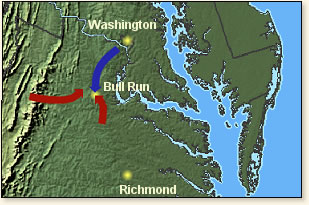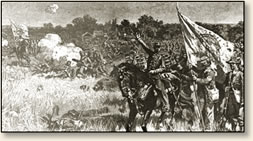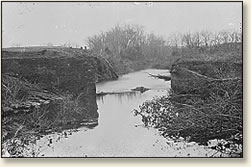|
The First Battle of Bull Run, 1861
In July 1861 the northern newspapers pressured President Lincoln to bring a quick end to the rebellion of the southern states. Adding to the strain was Lincoln's awareness that the ninety-day enlistments of the recruits who had responded to his call to arms after the attack on Fort Sumter were rapidly coming to an end. Something had to be done, and soon. Lincoln pressed for action. Despite his hesitancy that his troops were not yet adequately trained, General Irvin McDowell proposed a plan. He would  march his army of 35,000, currently bivouacked around Washington, thirty miles south and attack the Confederate forces defending the vital railroad junction at Manassas, Virginia. Victory would open the way to the Confederate capital at Richmond. march his army of 35,000, currently bivouacked around Washington, thirty miles south and attack the Confederate forces defending the vital railroad junction at Manassas, Virginia. Victory would open the way to the Confederate capital at Richmond.
The Union troops were indeed inadequately trained. It took over two days for them to march twenty-two miles south. The summer heat was oppressive. Many of the young soldiers wandered from the line of march to pick berries and rest. The Union army finally reached its objective on the evening of July 18 and encamped along a small stream known as Bull Run. The green troops needed rest and their stocks of food and ammunition that had been discarded along the road had to be replenished.
The Confederate spy network gave a forewaring of the Union intentions and allowed
Southern reinforcements to be moved from the Shenandoah Valley to Manassas.
Even the public was aware of the Union's plans. On the day of the battle, carriages
filled with spectators eager to see the Confederate defeat flocked from Washington
to the battle site.
Despite these disadvantages, the North almost won the day. During the early morning hours of Sunday July 21 the Union troops charged across the stream in front of them and pushed the Confederates into a defensive position atop a hill. Confusion reigned on both sides as the battle see-sawed throughout the day. Emboldened by the arrival of reinforcements and by the first use of the blood-curtailing Rebel Yell, the Confederates charged forth in the late afternoon. The Union line melted away. Retreat quickly transformed into mindless rout as the Northern troops rushed head-long back to Washington, discarding much of their equipment along the way. It was a decisive Southern victory. However, sheer exhaustion prevented the Confederates from pursuing the fleeing enemy and capitalizing on their triumph.
Samuel J. English was a Corporal in Company D of the Second Rhode Island Volunteers. Shortly after the battle he wrote his mother a letter describing his experience. We join his story in the early morning hours before the battle:
"Sunday, the 21st about 2 o'clock the drums beat the assembly, and in ten minutes we were on our march for Bull Run having heard the enemy were waiting to receive us, our troops then numbering 25 or 30 thousand which were divided into three columns ours under Col Hunter taking the right through a thick woods. About eleven o'clock as our pickets were advancing through the woods a volley was poured in upon them from behind a fence thickly covered with brush; the pickets after returning the shots returned to our regiment and we advanced double quick time yelling like so many devils.
On our arrival into the open field I saw I should judge three or four thousand rebels retreating for a dense woods, firing as they retreated, while from another part of the woods a perfect hail storm of bullets, round shot and shell was poured upon us, tearing through our ranks and scattering death and confusion everywhere; but with a yell and a roar we charged upon them driving them again into the woods with fearful loss. In the mean time our battery came up to our support and commenced hurling destruction among the rebels.
 |
Confederate troops in action at the battle.
From a contemporary illustration.
|
Next, orders were given for us to fall back and protect our battery as the enemy were charging upon it from another quarter, and then we saw with dismay that the second R. I. regiment were the only troops in the fight; the others having lagged so far behind that we had to stand the fight alone for 30 minutes; 1100 against 7 or 8 thousand. It was afterwards ascertained from a prisoner that the rebels thought we numbered 20 or 30 thousand from the noise made by us while making the charge. While preparing to make our final effort to keep our battery out of their hands, the 1st R.I. regiment then came filing over the fence and poured a volley out to them that drove them under cover again; they were followed by the New York 71st and the Hampshire 2nd regiments, with 2,000 regulars bringing up the rear who pitched into the "Sechers" (Secessionists) most beautifully.
Our regiments were then ordered off the field and formed a line for a support to rally on in case the rebels over powered our troops. When the line had formed again I started off for the scene of action to see how the fight was progressing. As I emerged from the woods I saw a bomb shell strike a man in the breast and literally tear him to pieces. I passed the farm house which had been appropriated for a hospital and the groans of the wounded and dying were horrible.
I then descended the hill to the woods which had been occupied by the rebels at the place where the Elsworth zouaves made their charge; the bodies of the dead and dying were actually three and four deep, while in the woods where the desperate struggle had taken place between the U.S. Marines and the Louisiana zouaves, the trees were spattered with blood and the ground strewn with dead bodies. The shots flying pretty lively round me I thought best to join my regiment; as I gained the top of the hill I heard the shot and shell of our batteries had given out, not having but 130 shots for each gun during the whole engagement. As we had nothing but infantry to fight against their batteries, the command was given to retreat; our cavalry not being of much use, because the rebels would not come out of the woods.
The R.I. regiments, the New York 71st and the New Hampshire 2nd were drawn into a line to cover the retreat, but an officer galloped wildly into the column crying the enemy is upon us, and off they started like a flock of sheep every man for himself and the devil take the hindermost; while the rebels' shot and shell fell like rain among our exhausted troops.
 |
A destroyed bridge over Bull Run.
|
As we gained the cover of the woods the stampede became even more frightful, for the baggage wagons and ambulances became entangled with the artillery and rendered the scene even more dreadful than the battle, while the plunging of the horses broke the lines of our infantry, and prevented any successful formation out of the question. The rebels being so badly cut up supposed we had gone beyond the woods to form for a fresh attack and shelled the woods for full two hours, supposing we were there, thus saving the greater part of our forces, for if they had begun an immediate attack, nothing in heaven's name could have saved us. As we neared the bridge the rebels opened a very destructive fire upon us, mowing down our men like grass, and caused even greater confusion than before. Our artillery and baggage wagons became fouled with each other, completely blocking the bridge, while the bomb shells bursting on the bridge made it "rather unhealthy" to be around. As I crossed on my hands and knees, Capt. Smith who was crossing by my side at the same time was struck by a round shot at the same time and completely cut in two. After I crossed I started up the hill as fast as my legs could carry and passed through Centreville and continued on to Fairfax where we arrived about 10 o'clock halting about 15 minutes, then kept on to Washington where we arrived about 2 o'clock Monday noon more dead than alive, having been on our feet 36 hours without a mouthful to eat, and traveled a distance of 60 miles without twenty minutes halt.
The last five miles of that march was perfect misery, none of us having scarcely strength to put one foot before the other, but I tell you the cheers we rec'd going through the streets of Washington seemed to put new life into the men for they rallied and marched to our camps and every man dropped on the ground and in one moment the greater part of them were asleep. Our loss is estimated at 1,000, but I think it greater, the rebels lost from three to five thousand."
References:
Samuel English's letter appears in Rhodes, Robert H. (editor), All for the Union (1985); Buel, Clarence, and Robert Underwood, ed., Battles and Leaders of the Civil War, vol I (1888, reprinted1982); Foote Shelby, The Civil War, A Narrative, Fort Sumter to Perryville (1986); McPherson, James M., Battle Cry of Freedom
How To Cite This Article:
"The First Battle of Bull Run, 1861", EyeWitness to History, www.eyewitnesstohistory.com (2004).
|






